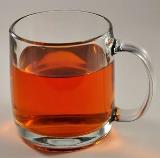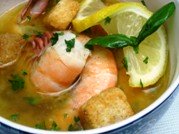|
The shrimp life cycle explained by Eagle Wood Farms, so you can comfortably purchase Wild Georgia Shrimp.
The shrimp spawn in the Atlantic Ocean and they swim at depths of about 20 to 60 feet about 4 miles off the coast. Shrimp typically live for one year and are considered a yearly crop. Males attach a sperm packet, called a spermatophore, to the female and the female will on average release 500,000 to 1 million fertilized eggs into the ocean. Fertilized eggs then drift in ocean currents and usually hatch in twenty-four hours. Within 30 days the fertilized egg will develop from a larval shrimp to a juvenile and will migrate back to brackish marshes. As omnivores , they feed on algae, small animals and organic debris. At about month four, the shrimp migrate back to the oceans and head south. Those that survive sea carnivores, trawlers and disease return to become next year's spawning stock. Some shrimp remain in the marshes and also become part of the new spawning stock. Water temperature, salinity, available food, water quality and habitat affect shrimp life. If the water is too fresh, shrimp will not enter the marshes and will not survive without the protection and food in the marsh vegetation. If they have already arrived when excessive fresh waters flow into these areas, large numbers may be killed by the sudden decrease in salinity. If the water gets too salty or cold, growth will slow down or stop. Best seasons occur when water conditions in the spring are warm and brackish; this is what makes the Georgia coast ideal for shrimp. January, February and March the shrimp lie dormant borrowed in the seabed. There is no fishing during these months. Shrimpers Long before it became politically correct, Georgia Shrimpers were environmentalists. Their very existence depends on the ocean, hurting that ecosystem would hurt their own livelihood. They don't want bycatch fish as it is costly to separate shrimp from other species. Bycatch is described as anything a fisherman catches other than what he seeks to net. Universities have provided historical information on the shrimp life cycle and since the 1500's, shrimping stayed unchanged with men using small hand held cast nets in shallow waters. It is speculated that Native Americans taught explorers the skills for harvesting and preparing shrimp. This changed around 1900 as powered boats dragging long nets became commercially viable. Within a generation the otter trawl, a cone shaped net, began use allowing shrimpers to harvest in deep water. This system remained viable for about 40 years. Information on the shrimp life cycle from various associations show that in the 1950s and '60s, shrimpers invented a simple device to exclude unwanted jelly fish. This was the beginning to eliminate bycatch, including turtles and fish. In the 1980s shrimpers so to eliminate turtles in their nets and developed the turtle exclusion device (TED) (trap doors). The generic term is Bycatch Reduction Device (BRD). Before the advent of TEDs and BRDs, it was estimated that shrimpers caught 10-to-20 pounds of fish bycatch to every pound of shrimp. Today, total finfish bycatch in the south Atlantic fisheries is down to 2.3 pounds of fish for every pound of shrimp, based on research from the National Marine Fisheries Service in 1997. The National Fisheries Institute's (NFI)(a seafood industry advocacy group) information on the shrimp life cycle from the year 2000 shows that the U.S. Coast Guard reported a 99 percent compliance rate with the federal regulation requiring shrimpers to use TEDs. In the 1970s, East Coast shrimpers established rules against fishing in the sounds or estuaries known as shrimp nursery grounds. They agreed to fish only the ocean waters where larger, more valuable shrimp migrate as they mature. Information on the shrimp life cycle from various government agencies show that the decrease in the turtle population is an evolving controversy. As is now coming to light, shrimp fishing was not the sole cause that endangered sea turtles such as the Green, Leatherback, Hawksbill, and Kemp's Ridley species. Research is beginning to show that the decline of those species was also caused by a result of the direct harvest of turtle eggs and turtles, especially the mature females as they came ashore to lay their clutches, by subsistence users in the Caribbean and other areas around the world. The U.S. shrimp industry is helping sea turtle conservation efforts by helping to protect nesting sites of the endangered Kemp's Ridley sea turtle on the beaches of Mexico. The nests, numbering only 702 in 1985, had multiplied to more than 6,054 by the year 2000. Processing Shrimp "You ready the vessel and try to be on the fishing grounds by daylight, which typically takes about two hours," says John Wallace, head of the Georgia Shrimp Association which provides much current information on shrimp. The harvester makes a two- to three-hour trawl (drag) for shrimp. Then the catch is dumped onboard by crew mates. Next the process of sorting, heading and icing begins. Georgia shrimp harvesters trawl up to seven miles from the beach. "After that, you've gone past the shrimps' food sources," says Wallace. "Ninety percent of shrimp are within four miles of the beach." Some shrimp harvesters in other states stay out on their boats an entire week, but on the Georgia coast, day trips are the norm. With returning nightly, there is no need for preservatives. The harvesting of shrimp, like all seafood in Georgia, is closely monitored by the FDA, and local food inspection organizations. Trawling is regulated and enforced by the coast guard and National Oceanic and Atmospheric Administration to ensure healthy stocks. Information on the shrimp life cycle can be found on these agencies' web sites. After the trawl the nets are pulled aboard, the shrimp is separated from the bycatch and the shrimp's heads are removed and the shrimp are placed on ice immediately. By mid to late afternoon the shrimper is in dock where his catch is weighed and he is paid the market rate for shrimp that day. The processor then transports the shrimp to a facility where the shrimp are sorted by size and either block frozen into 5lbs packages or individually quick frozen IQF into 2lb or bulk containers. There are no preservatives used. Processing ends the shrimp life cycle. All seafood processors, including shrimp processors are approved by the FDA and local health inspectors. On our shrimp packages you will notice a license number and the phrase FDA approved, HACCP certified. Hazard Analysis and Critical Control Points (HACCP) is a systematic preventive approach to food safety that addresses physical, chemical and biological hazards as a means of prevention rather than finished product inspection. HACCP is used in the food industry to identify potential food safety hazards, so that key actions, known as Critical Control Points (CCP's) can be taken to reduce or eliminate the risk of the hazards being realized. From here frozen shrimp are transported by refrigerated truck to Connecticut. We hope this information about the shrimp life cycle provides you with enough comfort to justify your purchase of Certified Wild Georgia Shrimp.
|



